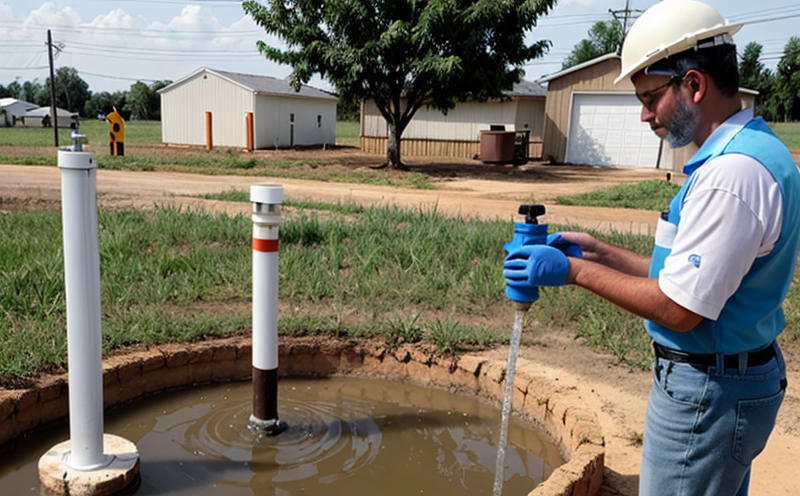EN 15309 Elemental Analysis of Soil and Groundwater
The European Standard EN 15309 specifies a method for determining trace elements in soil and groundwater using inductively coupled plasma mass spectrometry (ICP-MS). This standard is widely recognized for its precision, accuracy, and ability to detect low concentrations of various metallic elements. Elemental analysis plays a crucial role in environmental monitoring, particularly when assessing the impact of industrial activities or contamination from hazardous waste sites.
Groundwater quality testing under EN 15309 is essential for ensuring compliance with local and international regulatory standards such as the European Union’s Water Framework Directive (WFD) and the U.S. Environmental Protection Agency’s Safe Drinking Water Act (SDWA). The standard provides a harmonized approach to identifying elemental contamination, which can help prevent groundwater pollution that could affect public health.
The testing process involves several critical steps: soil or groundwater sample collection, preparation, digestion, and analysis. Soil samples are typically collected from various depths using suitable sampling techniques. Groundwater samples are usually extracted through boreholes equipped with appropriate samplers to minimize contamination. Once collected, the samples undergo thorough preparation, often involving acid digestion to release elements for detection.
The use of ICP-MS in EN 15309 ensures that even extremely low concentrations of trace metals can be detected and quantified accurately. This is particularly important when assessing the presence of contaminants such as arsenic (As), cadmium (Cd), lead (Pb), and mercury (Hg), which are known to pose significant health risks at very low levels.
The results obtained from EN 15309 testing are crucial for environmental risk assessment, remediation planning, and compliance reporting. The data generated can inform decisions on appropriate cleanup measures or changes in operational practices to prevent further contamination. By adhering to this standard, organizations ensure that their environmental management strategies are both effective and compliant with international best practices.
EN 15309 is applicable not only to industrial settings but also to agricultural lands where excessive use of fertilizers or pesticides might lead to soil contamination. The elemental analysis can help identify whether these substances have leached into groundwater supplies, affecting the quality of water resources used for irrigation or drinking.
Moreover, this standard supports research and development efforts aimed at understanding the behavior of trace elements in environmental systems. By providing consistent and reliable data across different regions and laboratories, EN 15309 facilitates better collaboration among stakeholders involved in environmental protection.
Benefits
Adopting EN 15309 for elemental analysis offers numerous advantages for organizations operating within the water and wastewater sector. These benefits include:
- Enhanced Compliance: Ensures that all tests conducted meet strict regulatory requirements set forth by international standards.
- Precision and Accuracy: Provides highly accurate measurements of trace elements, ensuring reliable data for decision-making purposes.
- Consistent Results: Laboratories following this standard will achieve consistent results regardless of location or equipment used, promoting trustworthiness in analytical outcomes.
- Improved Risk Assessment: Enables more informed assessments of potential risks associated with groundwater contamination, leading to proactive management strategies.
The use of EN 15309 also promotes transparency and accountability within the industry by providing clear guidelines for testing procedures. This standard helps build confidence among stakeholders regarding the integrity of analytical results produced by accredited laboratories.
International Acceptance and Recognition
EN 15309 has gained widespread acceptance across Europe and beyond, making it a preferred choice for elemental analysis in soil and groundwater. Its adoption reflects the growing global consensus on the importance of harmonized analytical methods to ensure consistent and reliable results.
The standard is recognized by numerous regulatory bodies including the European Commission, various national standards organizations, and international environmental agencies such as the World Health Organization (WHO). Laboratories accredited according to EN 15309 are often preferred partners for clients seeking assurance that their testing adheres to best practices.
International recognition extends beyond just compliance with regulations; it also enhances an organization’s reputation within its industry. By aligning with this standard, companies demonstrate their commitment to maintaining high standards of quality and reliability in environmental testing services.
The harmonization provided by EN 15309 allows for seamless integration between different national systems, fostering greater cooperation among countries working towards common goals related to environmental protection and sustainability.
Competitive Advantage and Market Impact
Implementing EN 15309 can give organizations a significant competitive edge by ensuring they meet or exceed the highest industry standards. By providing accurate and reliable data, companies can build stronger relationships with clients who value transparency and quality.
- Credibility: Clients are more likely to choose laboratories that comply with internationally recognized standards like EN 15309.
- Regulatory Compliance: Ensuring compliance reduces the risk of non-compliance penalties and enhances overall reputation.
- Innovation: The standard encourages continuous improvement in analytical techniques, leading to innovative solutions that address current challenges more effectively.
- Customer Satisfaction: Consistent high-quality results contribute to increased customer satisfaction and loyalty.
The market impact of adhering to EN 15309 extends beyond individual organizations. It contributes to broader efforts aimed at protecting the environment, ensuring public health, and promoting sustainable practices worldwide.





